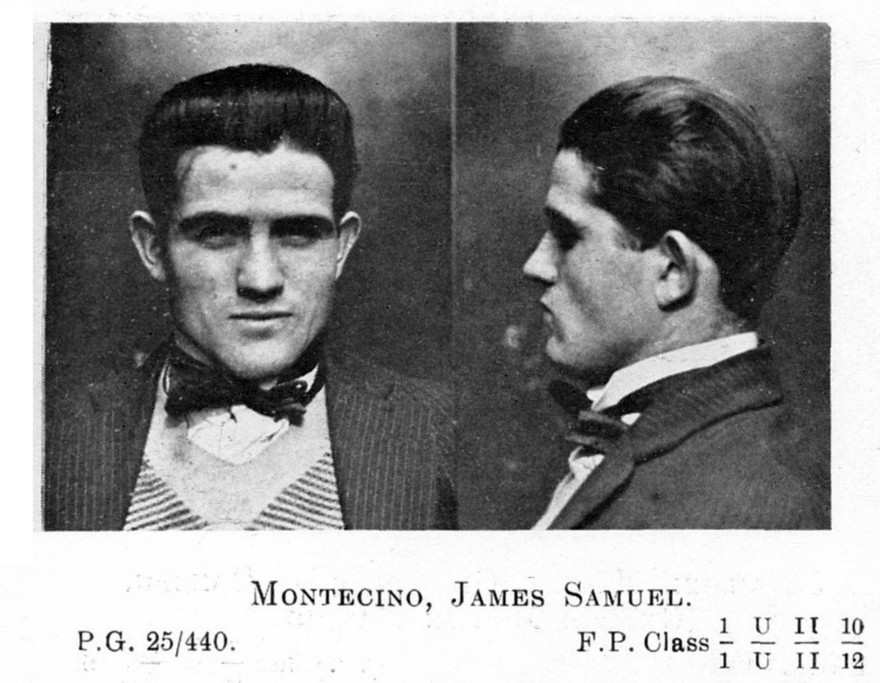
Wanted: James Charles Montecino's mugshot in the NZ Police Gazette, 2 September 1925. - PapersPast
When Jimmy Montecino played the piano, his wrists swelled up. Now barely remembered, he was an endurance pianist from a century ago, a honky-tonker who broke 57 non-stop playing records in so-called “pianothons”.
Napier-born James Samuel Montecino was an original tall poppy. In 1924, the newspaper NZ Truth tried to cut down the so-called “Melody Merchant” whose crowded, highly promoted record attempts earned him £1000 jackpots.
Certainly, Jimmy had form, for behaving outside the law – and social norms. Piecing together his wild and colourful life is a journey through old police files and tabloid headlines, as Jimmy gained fame, notoriety and a bunch of non-stop playing records. The police kept a close watch on the pianist, noting that he was “usually dressed in a wine-coloured suit with double-breasted coat and brown hat.”
Between so-called “pianothons”, he often ran afoul of the law. Jimmy’s serious offending peaked with five years jail in 1952. The NZ Police Gazette tut-tutted that he was someone who ‘frequents billiard halls and places of amusement.’
But the 21-year-old was a fighter, climbing into the legal ring with Truth, the now-defunct scandal sheet once famous for fake news. The spat was the start of a vaudevillian vendetta that lasted 55 years – and saw Jimmy bloody the paper’s nose. Twice.
Times were hard after the Great War. Jimmy had first worked as a shearers’ cook on a Gisborne sheep station until he lost everything, even his shirt, in a fire. He headed to Wellington, finding low-paid work as an expressman, or courier.
Endurance crazes were sweeping the world: marathon dances like those seen in 1969 film They Shoot Horses Don’t They? There were “anti-sleep” marathons where people gathered in public halls trying to keep awake while bands played lullabies. For those who lasted longest, the lure was the lucrative prize pool.
Auckland hosted a few of these capers, and Jimmy cashed in. His “pianothons” soon became weird and gruelling public spectacles. As the hours and days passed, he became delirious, his wrists grew inflamed, swelling up to twice their normal size.
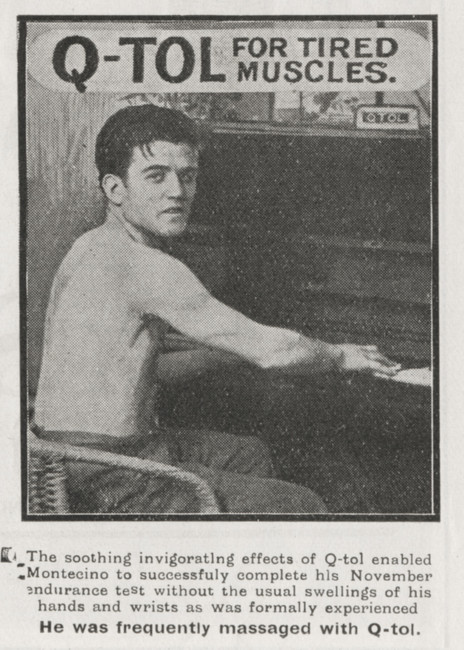
Montecino endorses Q-tol to soothe his wrists; an advertisement from 1925.
Truth recorded how an exhausted Jimmy would rest an elbow on the piano, banging the ebony and ivory with his fists. He would ramble incoherently, mostly about pies. Attendants rubbed him down with bottles of muscle relaxant Q-Tol, his main sponsor. He shaved one-handed, as he played on. And on.
To understand the wacky world of endurance events, we need to go back to the 1920s, the jazz-age era of silent movies and smoke-filled vaudeville shows, of Winter Shows and Carnival Weeks. Fun was in short supply: no laptops, no streaming.
Picture this: it’s August 1924, and bleak, downtown Wellington is cheering itself up with hoopla tents and army bands in the windswept streets. In a Lambton Quay shop window, a 21-year-old takes a seat at the piano. He is lit with spotlights.
A well-heeled Carnival Committee had signed Jimmy up to perform 100 continuous hours at the keyboard, to attempt a world record. The boy has form: he recently clocked up 57 hours of ragtime in Auckland, using the stage name Jim Robinson.
The “pianothon” begins on a Tuesday night, Jimmy decked out in white tennis trousers, a colourful shirt and bright socks. The paying crowds surge in; they watch him begin, applaud, then head home. And it is what unfolds in the wee small hours that attracts the attention of Truth, the self-appointed People’s Watchdog and biggest selling paper in the land.
For the rest of that week, Jimmy plays non-stop in the downtown shop, officially tallying up his 100 hours, as the crowds and excitement gather. Can the 21-year-old break the world record?? The moment arrived at midnight on the Saturday as a paying crowd of 500 cheers. He’s escorted to the town hall, a hero.
Truth remains suspicious. “Pianist Plunders Public” it soon shouts in a typically alliterative headline. With poisonous penmanship, the paper accused the 21-year-old of falsely claiming an endurance record based on “tinkling and snoozing”.
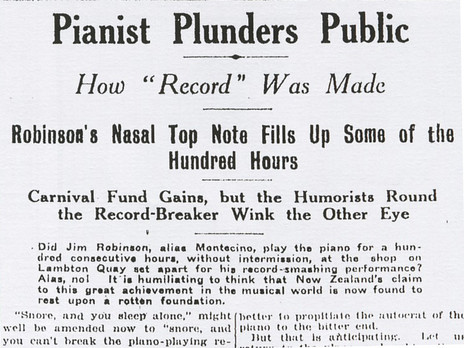
NZ Truth reveals deep scepticism about Montecino's melodious malarkeys, 2 August 1924.
“At the end of 100 hours 10 minutes, Robinson, aided by his doorkeeper and hangers-on, gave himself a rousing reception as world’s champion. He’d smashed the existing endurance record, he declared – but that he’d slept for 20 out of the 100 hours was not mentioned. In his waking hours, however, he collected much coin from a gullible public – and slept the sleep of the just when no one was present.
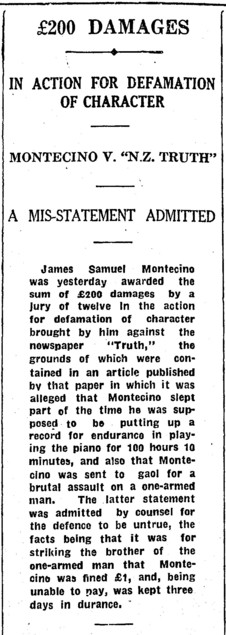
Montecino receives £200 in damages from NZ Truth. - Dominion, 15 November 1924.
“Indeed, his snores were so loud one night that the attendants, fearing he would attract the attention of a policeman on the beat, were forced to wake him. Unlike most pianists, Jim Robinson prefers a plain, homely name to a high-sounding foreign appellation. It may have been modesty that made him drop his real name of Montecino but then again it may not have been, for his card: ‘Jim Robinson Entertainer at Piano. World’s Champion On Tour’ hardly spells modesty, nor do his flamboyant shirt and taste in socks.”
Truth alleges Jimmy was asleep for at least 20 hours during that time, and that loud snoring proved to be his undoing. Jimmy was variously accused of vanity, fraud, playing too loudly, and worst of all, wearing a flamboyant shirt and tasteless socks.
The Napier battler put up his fists, sued for defamation and – to everyone’s astonishment – won. The nation’s most powerful print outlet had to eat humble pie, forking out big damages, about $24,000 in 2023 dollars.
Having met its match, the paper all but saluted: “It is more than cheek that has been given to Jim Montecino to battle his way through life: it is sheer audacity. It is Italian blood that runs in his veins; it might well be Corsican, for his audacity smacks of the Napoleonic.”
But the toughest, meanest and most powerful paper in the country had a long memory. Its subsequent actions prove it bore a grudge, though it would bide its time in getting even.
Flash forward 24 years, to 1952. Jimmy, based in Dunedin, is raising a family, and still attempting eye-watering “pianothon” world records. In 1932, he played for 175 hours. He’s now in his late forties, slowing down a bit.
In 1950, crowds fill Christchurch’s Realm dance hall to watch him play for 180 hours in an attempt to break his 1932 record of 175 hours. At the end, he collapses and is lifted from the piano.
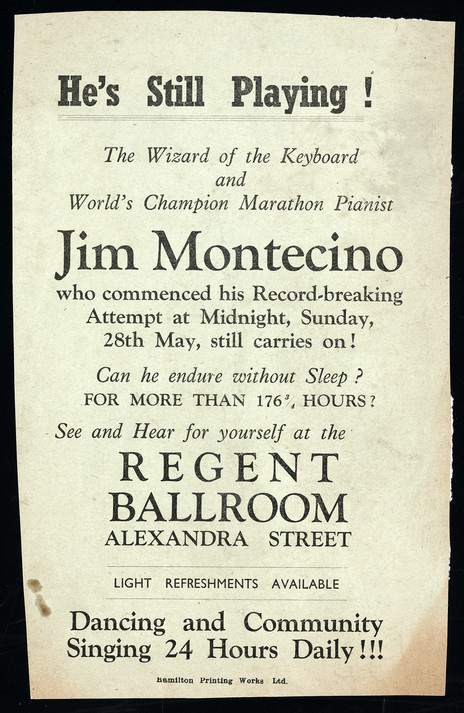
Can he endure without sleep? A 1950 flyer to encourage an audience to watch Montecino chase 177 hours in Hamilton. - Alexander Turnbull Library, Wellington. Ref: Eph-A-CABOT-Music-1950-01
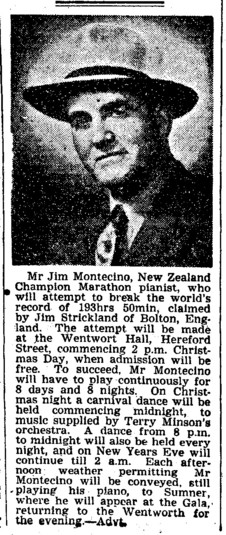
Montecino returns to Christchurch in 1951 in an attempt to break 193 hours 50 minutes. - The Press, 22 December 1951.
But Truth is more interested in his offstage life, especially a brush with the law two years later. Its 1952 report refers to a court case involving a certain 48-year-old “showman” and father of nine, harassing a lover less than half his age.
Lulu Smith, 23, had tried to break off their two-year relationship, and Jimmy responded by shooting at her relatives, and sending threatening letters to her new companion.
The judge, noting Jimmy’s string of convictions, including a 1927 assault on police, sentenced him to a total of five years’ hard labour and exhorted him to lose his obsession for the woman.
On his release in 1957, Jimmy left for Canada, remaining there for over 20 years. He embarked on a career as an endurance honky-tonk entertainer in Canada, performing in night clubs, shopping centres, and conventions. A highlight was his long-running stint at the Golden Garter Saloon at Expo 67 in Montreal.
In 1979 he returned home to New Zealand. In his luggage was a copy of a documentary about his life, Jimmy, Playing With Time. The amazing film had represented Canada at the Cannes Festival. Jimmy’s aim was to play in New Zealand clubs and screen the film, the climax of which was his high-profile performance at the Canadian National Exhibition, an attempt to break his 1950 world record. Filming began in 1976, on his seventy-third birthday.
Jimmy, Playing With Time shows how he sat down to play in brilliant sunshine, then rain poured through the top of the canopy of the float in which he was playing, drenching him and his piano.
He keeps playing until the storm passes, catching a cold, which turns into pneumonia. He lasts for five of the seven nights he had been contracted to play, until he collapsed. On the way to hospital, his heart stops and he’s revived.
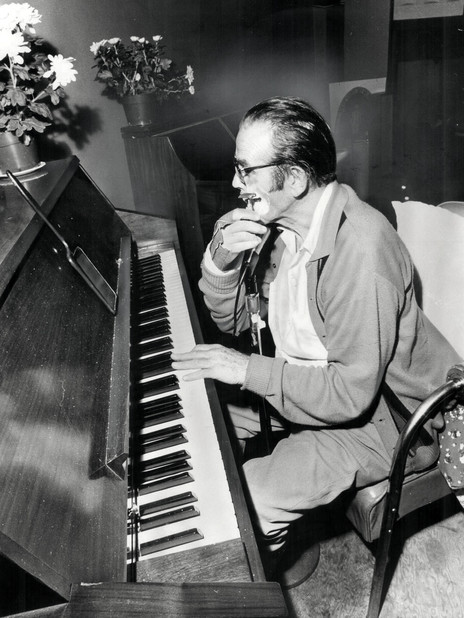
With a mirror as sheet music Montecino, 72, keeps playing the piano while performing his ablutions, three days into another marathon. - Photo by Doug Griffin, Toronto Star, June 1975
All of this was captured on film. Next day he summons his wife and asks for his clothes so that he could leave the hospital and perform that night. Which he does.
Jimmy tells the camera how his heart has stopped four times during a career in which he has broken 37 records.
“But I keep fooling them,” he says. “I am the same as I was 20 years ago. I look at a mirror and ask myself, ‘Why the hell don’t I grow old?’ There is not a grey hair in my head." Jimmy is legally blind, but spectacles help.
By the time of his return home, his old adversary Truth, too, had gotten old and careless. In its edition of 15 May, it repeated quotes from the original 1924 “Pianist Plunders Public” article, accusing him of conning the public.
It scoffed at the return of this “world champion,” foolishly repeating its allegations of 55 years earlier under the headline “Snoring his way to that record”. Bad idea.
When Jimmy’s lawyer followed up, Truth immediately issued a grovelling apology. But the 76-year-old was unmoved, issuing a writ for $125,000 damages, nearly $900,000 in today’s dollars. It was payback time.
Back in the spotlight, Jimmy sued again, and after a case lasting over a week – during which the jury watched the documentary – he was once more declared the winner.
Damages were awarded at $30,000 ($140,000 in 2023 dollars) but the old enemies later settled out of court for a reduced amount.
The presiding judge said libelling Jimmy once was bad enough. But for the same libel to be repeated 55 years later was nothing but an aggravation. The boy from Napier again won the day.
Jimmy returned to his beloved Canada, dying in Quebec on 19 August 1985 at the age of 81.
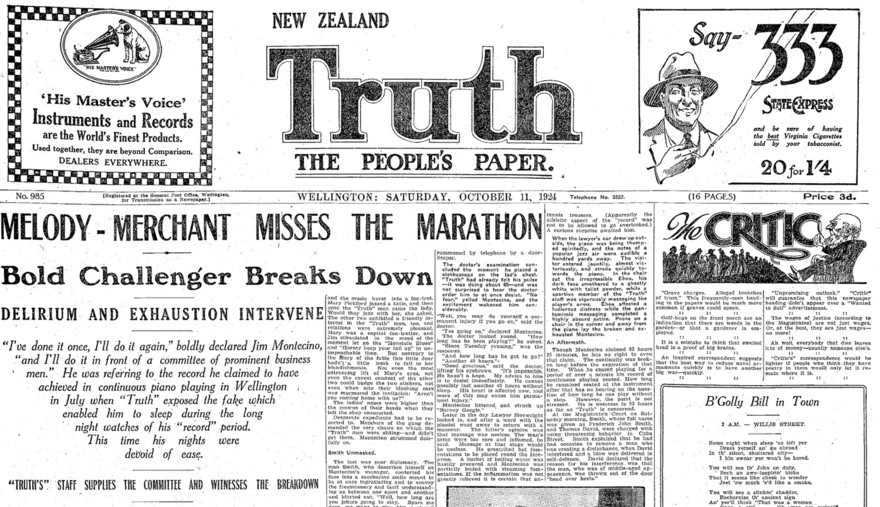
Truth's original defamatory front page story on Montecino, 11 October 1924. To read in full, go to Papers Past.
--
Redmer Yska is the author of several books, among them Truth: the Rise and Fall of the People's Paper (Craig Potton, 2010) and All Shook Up: The Flash Bodgie and the Rise of the New Zealand Teenager in the Fifties (Penguin, 1993).